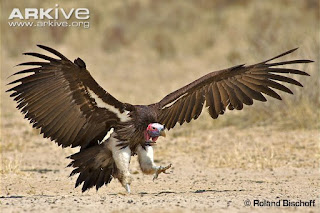 |
| Lappet-faced Vulture |
Of the over 500 species of diverse birds
found in the Kruger National Park, six of them are referred to as the Big 6 Birds
of the Kruger National Park.
Vultures are New World vultures or
like the lappet-faced vulture fall into the group of Old World vultures. The
lappet-faced vulture falls into two subspecies; the African vulture and the
Arabian vulture. The lappet-faced vulture is the most powerful of all African
vultures with the strongest beak.
The lappet-faced vulture is so
called due to its fleshy folds of skin, known as lappets, on the sides of its neck.
They have a wingspan of up to 280cm and are 115cm in length.
These vultures are blackish in colour with white thigh feathers and a white bar running across the edge of their under wings which are visible when flying. The African subspecies have black feathers on top lined with brown and their underside can range from white to brown while the Arabian subspecies are brown in colour on top.
The
lappet-faced vulture has a reddish to dull pink in colour bald head. A bald
head is easier to keep clean than a feathered head as spattered blood and small
specks of flesh would be difficult to clean off.
 |
| Close up of a lappet-faced vulture |
Habitat
These vultures live in the dry
savannah or thorn bush areas in the plains of Africa and can also be found in
the semi-arid desert. They prefer open land with a scattering of trees and
little grass cover. These vultures build a private nest in their pairs away
from other vultures.
Behaviour
Lappet-faced vultures are
usually silent and stay with their partner although sometimes gather in numbers
at watering holes or at the site of large carrion.
Diet
Vultures are well-known for being scavenger
birds. They are opportunistic feeders, finding their food by sighting carrion
from their perches or watching other vultures. The lappet-faced vulture is the
most dominating and aggressive of all the African vultures and other vultures
will back off of a carcass if the lappet-faced vulture affirms itself.
A lappet-faced vulture will often
wait for other vultures to finish feeding on a carcass so that they can strip
apart the remnant skin, tendons and other tissues that the other vultures cannot
eat. Lappet-faced vultures eat freshly
killed smaller mammals, birds and reptiles sometimes even attacking young and
frail live animals. They will also raid the nests of other birds in search of their
young to feast on. Vultures have been
known to eat the remains of dead human bodies.
After a feast the lappet-faced vulture finds a watering hole nearby to wash any off their face and neck. Vultures have super strong stomach acid which eradicate bacteria which would kill other animals if ingested.
After a feast the lappet-faced vulture finds a watering hole nearby to wash any off their face and neck. Vultures have super strong stomach acid which eradicate bacteria which would kill other animals if ingested.
Reproduction
They
start to breed from the age of 6 years old and most vultures mate for life. The
female lays 1 or 2 eggs at a time which are nurtured by both parents and the
young vulture hatches after spending 54 to 56 days in the egg.
 |
| Lappet-faced vulture landing. |
The youngster
usually leaves the nest between 124 to 135 days old but sometimes stay under their
parents care for up to a year or more. Each pair may have one to three nests
and are used over and over again.
Did you know?
They are able to shred a small antelope carcass to
the bone within 20 minutes.
The species is listed as vulnerable.

No comments :
Post a Comment